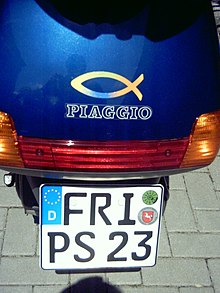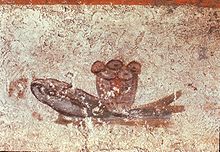Fish (christianity)

The Eucharistic fish are a common motif in early Christian art and can be found as wall paintings ; one of the first works of this kind can be found in the crypts of Lucina in the Roman Calixtus catacomb .
interpretation
The fish symbol and the sequence ΙΧΘΥΣ ICHTHYS played an outstanding role as an acrostic and acronym (or backronym , since there is no clear evidence of the meaning at the time of origin) in early Christianity . Following on from this, the Eucharist was symbolized in the wall paintings of the early Christian tombs mostly as the miraculous multiplication of the five barley loaves and the two fish to feed the five thousand ( Joh 6,1-15 EU ), at which Jesus promised his body ( Joh 6,51 EU ): “I am the living bread that came down from heaven. Whoever eats this bread will live forever. The bread that I will give is my flesh, (I lay it down) for the life of the world. "In addition to individual representation of a fish is placed on the bread basket, appears the motive for the symbolizing representation of the Eucharistic Sacrament on : Seven people (that is, called to salvation) always sit around a table. On the table are two or three platters of bread and fish as well as wine glasses and bread baskets on the floor.
History and background
A version passed down orally and later recorded in writing tells that the fish was used as a Christian identification mark. The Greek word for fish ἰχθύς ichthýs contains a shortened creed ( Ἰ ησοῦς Χ ριστός Θ εοῦ Υ ἱός Σ ωτήρ ):
Iota ΗΣΟΥΣ - I ēsoûs ( Modern Greek Ιησούς Iisoús ) "Jesus"
Χ ΡΙΣΤΟΣ - Ch Ristos "the anointed"
.theta ΕΟΥ - Th EEO (Modern Greek Θεού Theou ) "God"
Υ ΙΟΣ - H y IOS (Modern Greek Υιός Yios ) "son"
Σ ΩΤΗΡ - S ōtér (modern Greek Σωτήρας Sotíras ) "Savior" / "Redeemer"
The ( I · Ch · Th · Y · S -) symbol consists of two curved lines that represent a fish. There is no historical evidence that it was already used by the first early Christians as a recognition and secret sign : one person drew an arch in the sand, the other completed the symbol with the opposite arch and thus revealed himself as a brother or sister in Christ.
Tertullian (approx. 200 AD) speaks in his writing about baptism ( De baptismo 1,3) of Christ as the Ichthys, but the Christians as "little fish" born from the Ichthys.
The fish can be interpreted archetypically and in terms of depth psychology as a symbol for the (underwater) hidden truth that has to be caught, i.e. brought to light. At first it shimmers in secret, easily slips away from the fisherman, but promises food. In the story of Peter's fishing trip, Jesus shows himself to be the guide to the truth.
The symbol refers to the sentence from the Gospel of Luke ( Lk 5.10 EU ) “Jesus said to Peter: 'Do not be afraid! You will no longer catch fish, you will win people for me. '"
Use in modern times
While the symbol of the fish hardly played a role in Christianity after the 2nd century, it has been revived in the last few decades.
Since the 1970s, the fish symbol has been seen millions of times as a Christian symbol on cars, scooters and other objects, initially mainly in the evangelical field. In addition, the symbol appears more and more in church logos and graphics, right up to the (whale) fish of the YMCA at the Expo 2000 in Hanover or the key symbol of the German Evangelical Church Congress 2007 in Cologne, when the Hohenzollern Bridge over the Rhine was designed as an oversized fish . Sometimes the symbol itself is used outside of the churches, often without knowing the background.
The word Ichthys is also increasingly used as a name, from kindergartens to church services to church congregations or church institutions.
Parodies and polemics
As a result of the spread, there were also humorous modifications of the fish. For example, the Open Church in Württemberg advertised church elections with a shark and the slogan Church with Bite .
A religious parodistic variant of the symbol makes fun of the rejection of the theory of evolution by creationists . Al Seckel and John Edwards have proposed an alternative since 1983. To ironize creationism, they designed the Darwin fish, which is labeled with " Darwin " instead of "Jesus" and has legs as a symbol of evolutionary theory . Variants of this show z. B. a fish with legs that is holding a tool and is labeled "evolve".
Cthulhu fish as a symbol of the Cthulhu myth
Gefilte fish as an allusion to a traditional Jewish dish
Trekhtys based on Star Trek
Eagle catches fish of the right-wing neopaganism of the species community
literature
- Franz Joseph Dölger : Ichthys. 5 volumes. Aschendorff u. a., Münster u. a. 1910–1957, (Reprint in 6 volumes (Volume 5 in 2 volumes). Peter W. Metzler, Oberhausen / Duisburg 1999–2000, ISBN 3-936283-01-X , ISBN 3-936283-02-8 , ISBN 3- 936283-03-6 , ISBN 3-936283-04-4 , ISBN 3-936283-05-2 , ISBN 3-936283-06-0 ).
- Josef Engemann : Fish, fishermen, fishing. In: Real Lexicon for Antiquity and Christianity . Volume 7: Excommunication - Curse Formulas. Hiersemann, Stuttgart 1969, Sp. 959-1097.
- Meinolf Schumacher : The leaps of the fish. A meal prescription in metaphor and allegory. In: Journal of Church History . No. 102, 1991, pp. 307-312 ( digitized version ).
- Werner Tiki Coast Maker : What does this fish mean? A secret is revealed (= RBtaschenbuch. Vol. 556). R. Brockhaus, Wuppertal 1998, ISBN 3-417-20556-5 .
Web links
Individual evidence
- ↑ expo2000.de ( Memento from June 24, 2004 in the Internet Archive )
- ↑ Hohenzollern Bridge 2007
- ↑ Press release from February 9, 2009 on antitheismus.de








